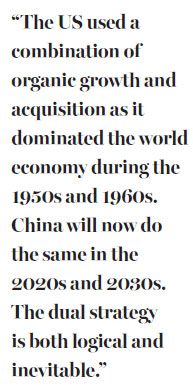If you can't beat them, then buy them
Updated: 2016-09-09 07:44
By David Haigh(China Daily Europe)
|
|||||||||
A mixture of acquisition and organic growth is likely to mark the international expansion of Chinese brands in coming years
China is the world's leading manufacturing economy. It is second only to the US in terms of GNP and is expected to overtake it within 25 years. The Chinese government has realized the value creation opportunity afforded by owning original intellectual property, whether technological and know-how-related or marketing and brand-related.
Also, China is leading the world in developing brand management and evaluation techniques, and once China sets its mind on becoming the leader in a field, it is usually foolish to bet against it. Chinese companies like Huawei, Haier, Hisense, Lenovo, Tsingtao and Geely are rapidly building strong global brands with Chinese roots.
One of the huge advantages for China's emerging brands is the vast domestic market, which creates a scale of operations before going abroad. For example, WeChat, the social networking and commerce website, has some 700 million users in China. Youngor, the apparel and suit business, has 300 million regular customers. This creates a huge revenue and profit platform and the ability to experiment in the home market before tackling more difficult foreign markets.
I have no doubt that in the coming years we will get used to seeing high-quality brands of Chinese origin appearing in all categories and in all countries worldwide.

But side by side with the organic growth of Chinese brands, we are also seeing Chinese companies and investors buying underperforming Western brands and turning them a round. Club Med, Gieves and Hawkes, Weetabix, Volvo, Rover, London Taxi Co and many other famous historical brands are now in Chinese hands.
It is often easier to penetrate a sector by purchasing pre-existing brands. In some cases, there are long-standing prejudices in favor of brands from certain countries, so Swiss watch brands, German car brands and French wine brands are all hard to beat. It is much easier to buy than to build from scratch, although in some sectors like high-technology or the internet this does not apply.
China needs to build similar prejudices in favor of its brands in certain sectors, perhaps in food, software or high-tech, so that consumers are predisposed to ask for Chinese brands in preference to others in sectors known to be Chinese strong points. But before then, it may be simpler to buy into the pre-existing prejudices.
Given the huge wealth accumulated in China, it is inevitable that more foreign brands will fall into Chinese ownership. In this respect, Chinese companies are simply following in the footsteps of US companies. A good rallying cry would be: "If you can't beat them, buy them."
One interesting issue is whether the push for Chinese expansion via acquisition will be primarily in consumer products and services or whether we can expect to see a much wider development in financial and professional services.
For example, it seems strange that the major global brands in accountancy, investment banking, management consulting and advertising mainly originate in Europe or North America.
A mixture of acquisition and organic growth will probably see this change over the next 20 years. When will we be talking about the Big Five accountancy firms, with one being Chinese-owned? Such services are crucial to the more rapid growth of Chinese-owned brands and brand portfolios in all the other sectors.
The US used a combination of organic growth and acquisition as it dominated the world economy during the 1950s and 1960s. China will now do the same in the 2020s and 2030s. The dual strategy is both logical and inevitable.
So for China, it is not one or the other, it's both, and this is a sign of China's rapidly growing economic power.
The author is chief executive officer of Brand Finance. The views do not necessarily reflect those of China Daily.
(China Daily European Weekly 09/09/2016 page8)
Today's Top News
No 'running commentary' on Brexit negotiations: PM
Girl earns $64,100 helping Chinese name their babies
Apple unveils iPhone 7, Pokemon Go coming to watch
Next step:Global action on growth
Greenland starts on UK's tallest residential building
Chinese women find their way through glass ceiling
China, UK vow to push 'golden-era' ties forward
MPs to debate second Brexit referendum petition
Hot Topics
Lunar probe , China growth forecasts, Emission rules get tougher, China seen through 'colored lens', International board,
Editor's Picks

|

|

|

|

|

|







